
TNU Journal of Science and Technology
229(06): 121 - 128
http://jst.tnu.edu.vn 121 Email: jst@tnu.edu.vn
REMOVAL OF DISPERSE RED 152 USING OZONE
COMBINED WITH ULTRASOUND
Nguyen Trong Nghia1*, Vu Thi Nu2, Nguyen Dinh Vinh3
1Hung Yen University of Technology and Education
2Bac Dong Quan High School, Dong Hung district, Thai Binh province
3TNU - University of Sciences
ARTICLE INFO
ABSTRACT
Received:
26/02/2024
The removal of organic dyes from wastewater is essential to protect the
ecosystem and human health. This study evaluated the ability of the
ozone system combined with ultrasound to remove organic pigment
disperse red 152 (DR152). Factors affecting DR152 removal efficiency
such as the combined effects of ozone and ultrasound, pH of the
solution, ozone dose, DR152 concentration, and temperature have been
systematically studied. The results showed that the combination of
ozone and ultrasound increased removal efficiency significantly with a
combined coefficient of 1.72. The kinetics of the treatment process
followed the first-order kinetic model. Optimal conditions for the
treatment process included pH = 7, ozone dose of 700 mg/h, and
temperature of 50 oC. The results also showed that the efficiency and
reaction rate depended significantly on the initial concentration of the
dye. The results obtained in this study demonstrate that the combined
ozone and ultrasound system has great potential for application in
removing organic dyes from wastewater.
Revised:
25/3//2024
Published:
25/3//2024
KEYWORDS
Ozone
Ultrasound
Combination
Disperse Red 152
Removal efficiency
NGHIÊN CỨU XỬ LÝ CHẤT MÀU DISPERSE RED 152
BẰNG PHƯƠNG PHÁP OZONE KẾT HỢP SIÊU ÂM
Nguyễn Trọng Nghĩa1*, Vũ Thị Nụ2, Nguyễn Đình Vinh3
1Trường Đại học Sư phạm Kỹ thuật Hưng Yên
2Trường THPT Bắc Đông Quan, huyện Đông Hưng, tỉnh Thái Bình
3Trường Đại học Khoa học - ĐH Thái Nguyên
THÔNG TIN BÀI BÁO
TÓM TẮT
Ngày nhận bài:
26/02/2024
Việc xử lý chất màu hữu cơ trong nước thải là rất cần thiết để bảo vệ hệ
sinh thái và sức khoẻ của con người. Nghiên cứu này đã đánh giá khả
năng xử lý chất màu dispersed red 152 (DR152) của hệ ozone kết hợp
sóng siêu âm. Các yếu tố ảnh hưởng đến hiệu suất xử lý DR152 như
ảnh hưởng cộng hợp của ozone và sóng siêu âm, pH của dung dịch,
hàm lượng ozone, nồng độ chất màu và nhiệt độ đã được nghiên cứu
một cách hệ thống. Kết quả cho thấy sự kết hợp của ozone và sóng siêu
âm làm tăng hiệu quả xử lý lên đáng kể với hệ số cộng hợp đạt 1,72.
Động học của quá trình xử lý tuân theo mô hình động học bậc nhất.
Điều kiện tối ưu cho quá trình xử lý bao gồm pH = 7, hàm lượng ozone
bằng 700 mg/h và nhiệt độ bằng 50 oC. Kết quả cũng cho thấy hiệu suất
và tốc độ xử lý phụ thuộc đáng kể vào nồng độ ban đầu của chất màu.
Kết quả thu được trong nghiên cứu này chứng tỏ rằng hệ kết hợp ozone
và sóng siêu âm có nhiều tiềm năng ứng dụng trong xử lý chất màu hữu
cơ trong nước thải.
Ngày hoàn thiện:
25/3//2024
Ngày đăng:
25/3//2024
TỪ KHÓA
Ozone
Sóng siêu âm
Kết hợp
Disperse Red 152
Hiệu suất loại bỏ
DOI: https://doi.org/10.34238/tnu-jst.9778
* Corresponding author. Email: nguyentrongnghia@utehy.edu.vn

TNU Journal of Science and Technology
229(06): 121 - 128
http://jst.tnu.edu.vn 122 Email: jst@tnu.edu.vn
1. Introduction
Wastewater containing organic dyes can significantly impact the environment if not
appropriately treated [1]. These dyes can contribute to water pollution, leading to a range of
ecological issues. The presence of dyes in water can alter its color and harm aquatic life,
including fish, invertebrates, algae, and other aquatic plants. The toxicity of dyes may stem from
their chemical composition and the byproducts of their degradation. Additionally, the
accumulation of toxic dyes in the food chain can affect higher trophic levels, including birds and
mammals. Therefore, the treatment of wastewater containing organic dyes is imperative to
minimize environmental impacts and safeguard water resources.
Ozone is recognized as a potent oxidizing agent capable of oxidizing a wide range of
substances, including organic compounds, metals, and microorganisms. Due to its strong
oxidative properties, ozone is employed in the treatment of wastewater containing organic
pollutants. This application leverages the ability of ozone to degrade various organic pollutants
into simpler, less harmful compounds [2]. The oxidation process with ozone involves breaking
the chemical bonds within organic pollutants, resulting in the formation of simpler compounds
that can be more easily removed [3]. A significant advantage of ozone treatment is its efficacy in
decomposing numerous types of organic pollutants within a short timeframe [4]. Ultrasonication
represents a widely adopted technique in wastewater treatment, attributed to its efficacy in
removing a diverse array of pollutants, including organic and inorganic compounds, suspended
solids, and pathogens [5]. Ultrasonic waves operate by generating high-frequency sound waves,
typically above 20 kHz, which induce pressure oscillations in the water. These pressure waves
lead to the formation and subsequent collapse of microbubbles filled with gas. The implosion of
these bubbles generates localized intense energy, producing high temperatures, pressures, and
shear forces, which contribute to the decomposition and elimination of pollutants [6].
The integration of ozone and ultrasonication technologies has been demonstrated to
significantly enhance the efficiency of wastewater treatment processes through synergistic effects
[7]. This combination is known to augment the production of hydroxyl radicals, which are highly
effective in breaking down pollutants. The high energy generated by ultrasonication can also
disrupt the cell walls of bacteria and other microorganisms, rendering them more susceptible to
oxidation by ozone [8]. In the study conducted by Shen et al. [4], the effects of combining ozone
with ultrasonication for the degradation of X-3B were investigated. The results indicated that the
O-U system exhibited a higher treatment efficiency compared to the use of ozone or
ultrasonication alone. The calculated synergy coefficient reached 1.42. Furthermore, in research
[8], the treatment of wastewater from gold refining processes containing cyanide ions was
explored using the combined ozone and ultrasonication approach. The authors reported that this
integration could comprehensively treat wastewater containing cyanide, effectively destroying
cyanide and facilitating additional copper recovery. The removal rate of cyanide and the copper
recovery rate achieved were 99.96% and 99.3%, respectively, under optimal conditions of ozone
flow rate at 80 L/h, temperature at 25 °C, reaction time of 15 minutes, and ultrasonic energy
density of 80 W/L.
This study aims to evaluate the treatment process of disperse red 152 (DR152) utilizing a
combination of ozone and ultrasonication. A systematic investigation was conducted on various
factors influencing the treatment process, including the synergistic effects, pH, ozone
concentration, dye concentration, and temperature.
2. Experiment
The treatment system for disperse red 152 (DR152) employing a combination of ozone and
ultrasonication is depicted in Figure 1. The system comprises a reaction vessel made from
polyethylene (PE), an ozone generator, and an ultrasonic bath. Initially, 1000 mL of the DR152

TNU Journal of Science and Technology
229(06): 121 - 128
http://jst.tnu.edu.vn 123 Email: jst@tnu.edu.vn
solution, with predetermined concentration and pH, was introduced into the reaction vessel.
Subsequently, ozone gas was infused into the solution via a gas distribution system from the
ozone generator, while ultrasound at a frequency of 40 kHz was applied to the treatment system.
At specific time intervals, 2 mL of the solution was extracted for analysis. The concentration of
DR152 in the solutions was determined on a V-770 (Jasco) spectrophotometer at a wavelength of
528 nm. The removal efficiency (%) was calculated using the following formula:
Removal efficiency =
100%
(1)
where Co and Ct are the DR152 concentrations (mg/L) of the initial solution and the treated
solution after t minutes, respectively.
Figure 1. Experimental diagram of treating DR152 with ozone combined with ultrasound: (1) - ultrasonic bath;
(2)-ozone gas distribution disc; (3)-DR152 solution; (4)-Reaction vessel; (5)-ozone generator; (6)-water
To study the synergistic effect of ultrasound and ozone, three series of experiments were
performed with a DR152 concentration of 200 mg/L at pH = 6. In the first series of experiments,
the solution was only affected by ultrasound, and in the second series only ozone was used with a
capacity of 1000 mg/h. In the third series of experiments, the solution was simultaneously
subjected to ultrasound and ozone. The influence of pH on the efficiency of DR152 treatment
with the O-U system was studied by changing the pH value of the reaction solution from 2 to 10
and the concentration of the initial DR152 solution was 200 mg/L. To evaluate the effect of
ozone dose on the treatment performance of the O-U system, the ozone content in the
experiments was changed from 200 to 1000 mg/h. These experiments were all conducted at pH =
7, DR152 concentration of 200 mg/L, and treatment time of 10 minutes. The effect of DR152
concentration on treatment efficiency was determined by changing its concentration from 100 to
600 mg/L. To study the effect of temperature on DR152 treatment performance, experiments
were conducted at different temperatures of 30, 40, 50, 60, and 70 oC.
3. Results and Discussion
3.1. The synergistic effect of ultrasound and ozone
To evaluate the synergistic effects of ultrasound and ozone in the treatment process, the
experiments were conducted under conditions of ultrasound, ozone, and combined ozone-
ultrasound. The outcomes are presented in Figure 2. The results indicate that the treatment
efficiency for the sample subjected to ultrasound alone was significantly low, achieving only
8.74% after 14 minutes. For the sample treated with ozone alone, the efficiency was considerably
higher, approximately 84% after 14 minutes of treatment. The highest treatment efficiency was
observed when combining ultrasound and ozone, exceeding 99% after 14 minutes. The
combination of ozone and ultrasound demonstrated synergistic effects that enhanced their
individual capabilities [4]. Ultrasound promotes the formation of additional hydroxyl radicals,

TNU Journal of Science and Technology
229(06): 121 - 128
http://jst.tnu.edu.vn 124 Email: jst@tnu.edu.vn
thereby enhancing the oxidative capacity of the ozone treatment process. The synergistic effect
results in a higher concentration of potent oxidizing agents, thus accelerating the decomposition
of DR152. Ultrasound increases mass transfer within the reaction system due to its ability to
enhance the mixing of substances and improve the dispersion of ozone in the solution. This
ensures better contact between ozone and the dye, increasing the overall effectiveness of ozone
usage. The increased decomposition efficiency achieved through the synergistic effect allows for
lower concentrations of ozone, reducing operational costs and minimizing the formation of
potentially harmful byproducts.
Figure 2. Treatment efficiency of DR152 by different systems: ultrasound (Us, black), ozone (Oz, red),
and ozone-ultrasound (O-U, blue) at pH value=6, temperature 30 °C, and dye concentration of 200 mg/l
To evaluate the synergistic effect of ozone, the synergistic coefficient was calculated
according to the formula [4]:
E = kU-O/(kOz + kUs)
(2)
where kU-O, kOz, kUs are the rate constants for the DR152 decomposition reaction in the ultrasound
system (Us), ozone (Oz), and combined ozone with ultrasound (O-U), respectively. These
constants were determined through analysis of experimental data using a first-order kinetic model
which is mathematically presented as the following equation:
Ln(Ct/Co) = -k*t
(3)
where Co and Ct are the DR152 concentrations before and after the reaction time of t minutes, and
k is the reaction rate constant. The calculation results from the first-order kinetic model for the
three systems are given in Table 1.
Table 1. Regression coefficients and rate constants calculated from first-order kinetic model
System
Kinetic equation
Rate constant
R2
Us
Ln(Ct/C0) = -0.016t
0.016
0.981
Oz
Ln(Ct/C0) = -0.133t
0.133
0.989
U-O
Ln(Ct/C0) = -0.257t
0.257
0.969
The correlation coefficient R2 for all three systems exceeds 0.95, indicating that the
experimental data for each system align well with a first-order kinetic equation. There is a
significant difference in the rate constants among the systems, with the ozone-ultrasound (O-U)
system exhibiting the highest rate constant. The synergy coefficient E equals 1.72, demonstrating
that the combination of ozone and ultrasound in the treatment system enhances the treatment rate.
This synergy likely stems from the enhanced generation of reactive species and improved mass
transfer, leading to more efficient degradation of contaminants.
0246810 12 14
0
20
40
60
80
100
Removal efficiency (%)
Time (min)
Us
Oz
O-U

TNU Journal of Science and Technology
229(06): 121 - 128
http://jst.tnu.edu.vn 125 Email: jst@tnu.edu.vn
3.2. Effect of pH on DR152 removal efficiency
In the process of treating organic substances using the O-U (ozone-ultrasound) method, the
pH value of the reaction solution plays a critical role because it affects the state of existence of
organic substances, the oxidizing potential of ozone, the ability to form free radicals, and the
interaction between oxidants and organic materials. To investigate the impact of solution pH on
the treatment efficiency of DR152, experiments were conducted across a range of pH values from
2 to 10. The results, presented in Figure 3, reveal a significant dependence of DR152 removal
efficiency on the pH. The treatment efficiency increased as the pH value rose from 2 to 7.
However, for samples at pH = 8, the removal efficiency at various time intervals was lower than
that for samples at pH = 7. The influence of pH can be elucidated as follows: at low pH values,
the concentration of hydroxyl ions (OH-) is relatively low. Consequently, the generation of free
hydroxyl radicals is restricted, leading to a decrease in the removal efficiency; as the pH of the
solution increases to 7, ozone becomes more stable at higher pH values, allowing it to persist in
the solution for a longer duration. This enhances the availability of ozone for oxidation reactions,
resulting in improved performance. However, when pH exceeds 7, the solubility of ozone in the
solution decreases, leading to a reduced capability of ozone to participate in oxidation reactions.
From the obtained results, it can be concluded that a pH of 7 is optimal for the treatment of
DR152 using the combined ozone-ultrasound process.
Figure 3. Effect of pH on DR152 removal efficiency by O-U method
3.3. Effect of ozone dose on DR152 removal efficiency
In the O-U method, the ozone dose is a critical parameter influencing the treatment efficiency.
To assess the impact of ozone dose on treatment performance, experiments were conducted at a
pH of 7, with a dye concentration of 200 mg/L and a treatment time of 10 minutes. The ozone
dose in these experiments was varied across different levels including 200, 300, 400, 500, 600,
700, 800, 900, and 1000 mg/h. The relationship between the removal efficiency and ozone dose
is depicted in Figure 4. The results demonstrate that the removal efficiency rapidly increases
from 30.87% at 200 mg/h to 45.72%, 61.98%, 77.89%, 90.84%, and 96.73% for ozone
concentrations of 300, 400, 500, 600, and 700 mg/h, respectively. However, when the ozone dose
increases to 800, 900, and 1000 mg/h, the removal efficiency shows little change. The influence
of ozone concentration on efficiency can be explained as follows: at lower ozone doses (200-600
mg/h), the removal efficiency of DR152 increases due to the higher ozone dose, which raises the
concentration of ozone molecules in the solution, leading to stronger oxidation reactions with the
organic dye; once the ozone dose reaches 700 mg/h, further increases do not improve dye
removal efficiency due to ozone concentration saturation. From these results, it can be concluded
that an ozone concentration of 700 mg/h is optimal for the treatment process of DR152 using the
O-U system.
2 3 4 5 6 7 8 9 10
0
20
40
60
80
100
Removal efficiency (%)
pH (-)




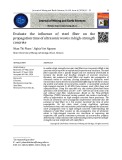
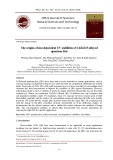
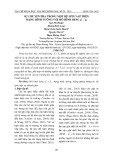
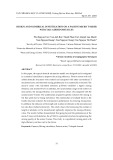
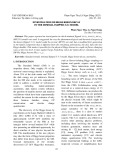
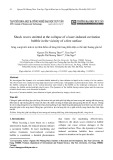
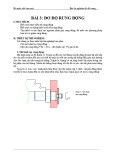

![Tài liệu Vi sinh vật môi trường [Mới nhất]](https://cdn.tailieu.vn/images/document/thumbnail/2025/20251123/ngkimxuyen/135x160/21891763953413.jpg)
![Sổ tay truyền thông Phân loại chất thải rắn sinh hoạt trên địa bàn tỉnh Quảng Nam [Chuẩn nhất]](https://cdn.tailieu.vn/images/document/thumbnail/2025/20251114/kimphuong1001/135x160/1701763094001.jpg)


![Quản lý chất thải nguy hại: Sổ tay Môi trường [Chuẩn nhất]](https://cdn.tailieu.vn/images/document/thumbnail/2025/20251029/kimphuong1001/135x160/9011761720170.jpg)









